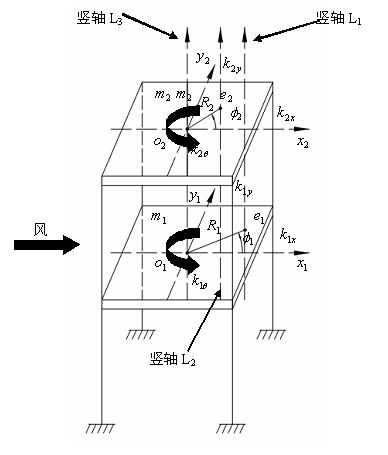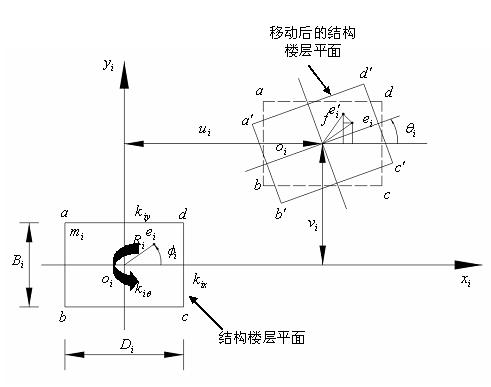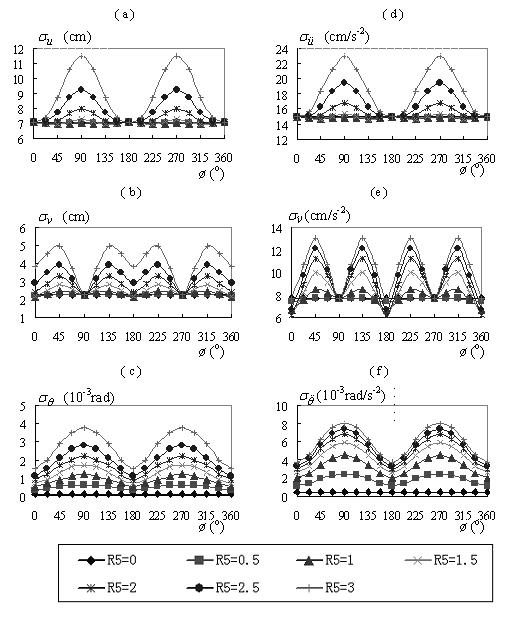Analysis method for translation-torsion coupling wind induced oscillation response of non-coaxial rigidity eccentric structure
A technology of eccentric structure and analysis method, used in special data processing applications, instruments, electrical digital data processing, etc.
- Summary
- Abstract
- Description
- Claims
- Application Information
AI Technical Summary
Problems solved by technology
Method used
Image
Examples
Embodiment 1
[0033] The method for analyzing the response of the non-coaxial rigid eccentric structure to the coupling wind vibration is characterized in that the operation steps are as follows:
[0034] 1) The stiffness eccentricity of each layer of the structure is expressed in the form of polar coordinates;
[0035] 2) Establish the dynamic equation of the non-coaxial stiffness eccentric structure;
[0036] 3) Select the structural model, determine the model parameters, and use polar coordinates to represent the non-coaxial stiffness eccentricity of the structure;
[0037] 4) Based on the power spectrum of downwind, across-wind and torsional wind loads, considering the correlation between the across-wind and torsional wind loads and the coupling between modes, the wind-induced translation-torsion of non-coaxial mass eccentric structures is performed in the frequency domain Coupled response analysis;
[0038] 5) By setting the structural stiffness eccentricity at different posi...
Embodiment 2
[0040] This embodiment is basically the same as the embodiment, and it is characterized in that the step 1) uses polar coordinates to represent the stiffness eccentricity of each layer of the structure: when the displacement of the geometric center of the structure in the downwind direction is , the crosswind displacement is and the torsional displacement is When , the polar coordinate expressions of the stiffness center in the downwind direction, across the wind direction and torsional displacement are:
[0041] (1)
[0042] (2)
[0043] (3)
[0044] In the formula, is the radial coordinate of the stiffness center, is the angular coordinate of the stiffness center.
Embodiment 3
[0046] see figure 1 and figure 2 , the analysis method steps of the non-coaxial stiffness eccentric structure coupled torsion wind vibration response are as follows:
[0047] In the first step, polar coordinates are used to represent the eccentric position of the structural stiffness.
[0048] In the second part, the dynamic equation of the non-coaxial stiffness eccentric structure is established, and the equation is shown in formula (5).
[0049] In the third step, the selected structure is a building whose plane size is ,high For a rectangular steel structure building, the damping ratio is assumed to be 1%, the average wind speed at 10m is selected as 15m / s, and the statistical correlation between the cross wind direction and the torsional wind load is 0.7. Other structural model parameters are shown in the table below:
[0050]
[0051] The fourth step, based on the power spectrum of the downwind, across-wind and torsional wind loads, considering the correlation b...
PUM
 Login to View More
Login to View More Abstract
Description
Claims
Application Information
 Login to View More
Login to View More - R&D
- Intellectual Property
- Life Sciences
- Materials
- Tech Scout
- Unparalleled Data Quality
- Higher Quality Content
- 60% Fewer Hallucinations
Browse by: Latest US Patents, China's latest patents, Technical Efficacy Thesaurus, Application Domain, Technology Topic, Popular Technical Reports.
© 2025 PatSnap. All rights reserved.Legal|Privacy policy|Modern Slavery Act Transparency Statement|Sitemap|About US| Contact US: help@patsnap.com



